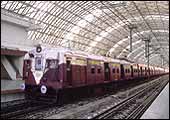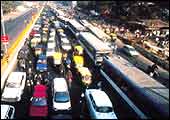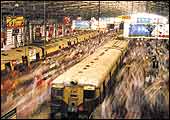 |
| Bangalore's elevated light rail transit system
is mired in red tape |
Transportation
experts will tell you that a city needs a mass transit system when
its population crossed 1 million. By those standards, 35 Indian
cities are eligible. Yet, only Kolkata has a small metro system.
Chennai's new system-running at only a sixth of capacity because
buses serve the same route better and more cheaply-runs over exactly
8.55 km. And only 16 km of Delhi's under-progress mass transit system
will be running by 2003.
But Bangalore's Elevated Rail Transit System
must surely win some sort of an award for sloth.
The need for a mass transit system was projected
as early as 1988, when a World Bank study said that the rate at
which the population was growing and the traffic density was increasing,
made it imperative for Bangalore to have a mass rapid transit system.
The population of Bangalore then was 3.4 million.
Today, its 7.2 million people are served by a grossly inadequate
fleet of 1,800 buses and 60,000-strong fleet of smoke-belching autorickshaws.
No wonder, then, that Bangalore has the largest personal transport
fleet-more than 9 lakh two-wheelers-in the country after Delhi.
It took the Karnataka government five years
to set-up a committee to examine whether a mass transit system was
needed. Finally in 1993, the Karnataka government decided to build
an elevated light rail transit system (ELRTS): a 99-km system of
air-conditioned light coaches borne on viaducts on arterial roads.
It made sense. Elevated tracks cost Rs 100 crore per km compared
to Rs 300 crore per km of underground railway. Surface tracks are
cheaper by 25 per cent, but where's the space? ELRTS' total cost,
estimated at Rs 4,000 crore in 1994, has ballooned to Rs 10,000
crore. The government-owned Bangalore Mass Rapid Transit System
Ltd was set up in 1994. Since 1995, a cess was levied in Karnataka
to garner funds, but only Rs 290 crore has been collected over six
years.
 |
| Chennai's 8.55 km-long mass transit system is
struggling |
Its not just about money, it's about planning
and common sense. Chennai's fledgling mass transit system runs at
a sixth of capacity, a ridiculous statistic in a country where buses
and trains are always full. That's because buses cover more ground
and do it more cheaply than the limited mass transit system in Chennai.
The people who built the system, the Indian Railways, didn't think
it worth their while to sort out the details with the officials
who run the city. Instead of complementing the bus system, the mass
transit system competes with it. And since the Railways have invested
a lot of money in the system, there's no likelihood of fares-costly
to those used to the cheaper buses-coming down. There are no hope
of profits in Chennai.
In Bangalore, it was clear from the start that
a private partner was needed. Nearly all mass transit systems run
at a loss worldwide. In 1996, the UB Group won a global bid. Since
then, it's been a litany of delays and disputes. The government
and the UB group are presently re-negotiating financial terms. If
all goes well, the first trains might start running by 2007 over
the first phase of 21 km. As for the second phase of 64 km, no one's
even talking about it.
-Venkatesha Babu & Nitya
Varadarajan
Commuter Diaries: Days In
The Life Of The Traveller
 |
Delhi: Battling For Survival On The Road,
Reading Hope In The Signs
It was my first week in Delhi, and
I was on my way to office in Connaught Place. It was 9 a.m., and
I had to be in before 10, or else join the sack race. I rose at
7 a.m. and was in the bus by 9:10. Middle-income office-goers clerks,
secretaries, travel agents joined me on the chartered bus. Almost
immediately, the overworked speakers pounded out the latest in Punjabi
pop as the conductor pounded on the side of the bus to clear the
way ahead. After a week of back-crunching stops and abuses, I had
enough. I know there's a ring railway somewhere, but where? The
next day, I get on my motorcycle, like 22 lakh others. We weave
through the buses and some of the 9 lakh cars. The air is surprisingly
clean, thanks to the CNG the buses and autos now imbibe. But driving
is getting harder. About 10,000 new vehicles join the daily battle
every month, ensuring the once open six-lane roads are medieval
jousting grounds.
But every day, I see more men in those yellow
hard hats. I see the hope in the signs they place on excavated streets,
pavements and parks-they read, Delhi Metro.
-Moinak Mitra
 Mumbai:
Surviving Crush Hour And Dreaming Of The West Island Freeway. Mumbai:
Surviving Crush Hour And Dreaming Of The West Island Freeway.
The blast of the air horn of the 7:59
Churchgate local jars me awake from my standing snooze. I clutch
the well-worn iron grip tightly as the train's motors whine their
way out of Borivali station. Office goers fling themselves aboard
desperately. The next train is five minutes away. But in the mad,
frantic rush of the Mumbai commute, these few minutes could mean
missing the next of a series of links that makes up an average Mumbaikar's
daily grind: The bus from the station, the share-taxi, the car pool,
the lift on the collegue's bike-every step is charted with split-second
precision. This is a first-class compartment, but I'm squashed in
between veterans who've buried their head in papers neatly folded
to book-size. I'm one of the five million who spend an average of
two hours on the trains. On the roads, 55,000 smoke-belching taxis
are stuck in ever-increasing, jams. The humid air is acrid and insufferable.
The trains are jammed to four times their capacity, but there's
no choice. Yes, I've heard of the West Island Freeway, the roadway
that will soar over the western seaboard, and deposit us downtown.
We've all heard of it-for the last 20 years.
-Abir Pal
 Bangalore:
Living My Life Without Fourth Gear Bangalore:
Living My Life Without Fourth Gear
My car has a fifth gear, but I've never
used it in Bangalore. Actually, I've rarely got beyond third. Driving
a car in Bangalore means competing against the streams of two-wheelers-just
one of 9 lakh-that clog the once-empty roads. As I grow older I
don't fancy myself doing the weave-of-death astride a scooter or
motorcycle. So I drive, slowly, breathing in the foul exhaust of
the thousands of vehicles forced on our roads because we have no
transport system worth the name. I see school children hanging to
life on the footboards of the 1,800 rickety buses, or packed in
like sardines in a cycle-rickshaw with a precarious, rusting iron
cage on its back. I see the hard-working folk stuck in buses for
an hour for a 14-km commute. Of course, we do have flyovers now-exactly
two of them. To top it all, I pay more for my petrol than anywhere
else in India: I'm contributing my bit to fund the Bangalore light
rail elevated system. I've been doing it for six years now, and
I'm told I might see the first train by 2007. Which means they might
start construction by then. Hurrah! At least my children will be
able to use the fifth gear.
Venkatesha Babu
Suburbia's Sprawl And The
New Outlying Culture
 |
| Salt Lake City, Kolkata: absorbing the swamp
of grandma Kolkata |
Like everywhere,
Indian suburbia strives to better the decaying city, creating its
own nuances. ''The suburb has not really thought of itself as outside
the city,'' says Dr Radhika Chopra, a sociologist at the Delhi School
of Economics. And so India's suburbs have developed into little
escapist fantasies, chiefly of the professional and middle classes
who've found themselves priced out of the city centres. Yet each
city as greatly influenced its suburbia.
Delhi's coveted suburb Gurgaon, she points
out, ''has transformed into DLF City getting an urban layering over
the rustic gown.'' So Gurgaon is a strange mix of the village and
the mall, the Opel and the plowshare. Delhi is built on an imperial
theme with the concept of a centre paramount, which its suburbs
reciprocate. Gurgaon's centre, they say, is built on hyperspace-sociologists
call this the space that is occupied on cultural differences. Hyperspace
survives by cannibalising aesthetics, says Chopra. So the Corinthian
columns, cafes, and other embellishments borrowed from the city.
Mumbai's suburbs, like Andheri and Borivili,
are home not just to a strong working class but also a professional
middle class. The suburbs are in a way syncretic to the culture
of Mumbai and the strong local train network binds the city and
its suburbs in one unit. Mumbai's inner suburbs like Bandra, Juhu,
Powai, and Ville Parle are unusual in that they are home to people
you would not find in the suburbs in other cities. Many of the super
rich-film stars, producers, builders-have made their home here in
soaring, ultra-luxury apartments, the likes of which are often not
available in the city centre. So there are neo-American complexes-self-contained
townships really-with monster Honda motorcycles and Mercedes SLK's
cruising down their smooth roads. Outside these townships, built
by builders like Lokhandwala and Hiranandani, the chaos of Mumbai
reigns supreme.
Kolkata's suburbia is evolving with the marshy
Salt Lake encroaching over more marshes to the city's east and north-east.
And the typical residents of these expanding marshlands are the
retired parents of salaried, non-resident Calcuttans who regularly
pump in more greenbacks than Indian currency to see this new Kolkata
take wing.
Chennai's chief suburb, Tambaram, is a proper
residential area well-connected by the city, particularly by its
arterial railway network. It takes a mere 30 minutes to chug your
way into Chennai Central. Tambaram has a strong middle-class and
professional composition, much like the Mumbai suburbs, and shares
its space with a host of manufacturing units.
Bangalore's windswept suburbs are occupied
by middle and upper-rung professionals, who work in the shiny new
office complexes that have sprung up where there were once rose
gardens and coconut groves. Whitefield, once a haven for retired
defence officers and the occassional chicken farmer, today houses
some of the best known names in the tech business: GE, Wipro, Bell
Labs, and Lucent, to name a few. Like Gurgaon, Whitefield is surrendering
to gentrification as many of the old farmers are selling out and
raking in their windfalls as land prices soar.
Malls. Condominiums. Clubs. Is this the way
of the future for India's suburbia? It might look that way, but
it's impossible to ignore the 'real' India outside the gates. Life
may he hectic and promising for the achievers who flood suburbia.
But their world will remain within their gates. Outside, they will
be dodging that cow and jarring their suspensions on the rutted
outer roads. Like our cities, suburbia's culture will echo all the
contradictions of the new India.
-Moinak Mitra
|

